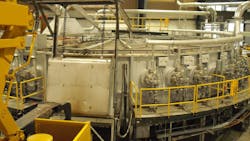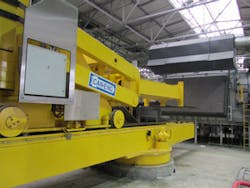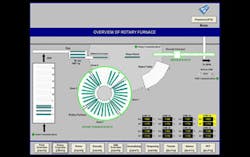Automated Reheating for Forging Steel
Operating costs are one of the primary concerns for every manufacturer looking for ways to increase their bottom-line revenues, and for producers of critical parts like forgings there is a constant effort to identify, contain, and minimize operating costs. In forging operations, billet and bloom heating is an essential process, one that must be optimized in order to maintain process efficiency.
The main cost considerations in forging are billet and/or bloom reheating, labor, and maintenance. The evaluation of the forging process should be total cost of ownership (TCO), taking into account both the capital investment and ongoing costs associated with the operation. In an ever-more competitive global environment for both closed-die and open-die forgings, automation combined with synchronous flow manufacturing offers forgers the opportunity to drive down costs. Such techniques combined with improved and more fuel-efficient combustion systems, and higher order Supervisory Control (SCADA)/Level II Automation, will create an environment of lowest TCO, and allow a U.S.-based forger to competed effectively with forging suppliers from India and China. While we recognize that open die Ingot Forging plays a significant role in the overall forging business, this article will concentrate on the potential for automation in the Reheating of Billets and Blooms with application to both closed and open die forge shops.
Heating as a Continuous Process
In forging operations, automation systems that manage loading and unloading of batch and continuous forging furnaces may incorporate flexible loading schemes that accommodate a range of billet and bloom sizes, reducing fuel consumption, maintenance and labor costs. By integrating these systems to create a continuous manufacturing process, losses in time and temperature can be minimized.
The design of an automated furnace cell must address several critical factors, but the method for conveying billets and/or blooms through the furnace is the main consideration. There are numerous methods of continuous conveyance for billets and blooms in forging reheating applications, including walking beam/walking hearth, rotary furnaces, pusher furnaces, and slot furnaces.
Rotary furnaces have proven to be a very reliable, rugged way to heat multiple billet and/or bloom sizes. Incorporating a dedicated robot into a rotary furnace cell will optimize loading in a way that is repeatable and accurate. This produces programmed movement within the cell that can be optimized further for transfer speed and cycle time.
Continuous heating usually involves a larger furnace system designed to incorporate a customer’s current or future product mix. Often, a continuous furnace can replace multiple batch furnaces to reduce the amount of labor required to tend each furnace. Automated loading and unloading, with billet de-bundling systems and integrated robotics, will reduce further the manual labor requirements.
Similarly, a continuous furnace system will reduce the amount of fuel required to process the same amount of product that would be processed in multiple batch systems. Some of the efficiencies that can be achieved by continuous heating are easy to recognize.
By design, a continuous furnace is engineered to achieve greater fuel efficiency in comparison to a “slug-fed” batch furnace. Some of the efficiencies that can be achieved by a continuous furnace system are easy to recognize: Door opening losses can be minimized, for example, and the thermal recovery time to reestablish the optimal heating temperature is much less of a factor and results in net savings in energy consumption.
Sized to Match Production
Most forging operations can be improved by installing a continuous heating furnace, though the design must be adapted to the needs of the operation. Furnace size can be a limiting factor for a continuous furnace system, but typically a continuous furnace sized to match the production in batch furnaces will have a smaller overall footprint.
Typically, to achieve complete automation, the installation would include a billet and/or bloom debundling station, a robotic manipulator to place stage product, an entry-side conveyor system, the furnace, and an exit-side conveyor system. Such an optimized heating cell takes into consideration the product flow of a forging operation.
When developing a new installation, material handling activity can be reduced by incorporating automated saw cutting operations close to the furnace heating cell, and laying out the operation so that production flows from raw material to final shipping.
When revamping an existing operation, the positioning of the furnace system is determined by the optimal location for picking up the feedstock, so as to achieve the greatest reduction in billet and/or bloom handling by the plant operators.
Forging materials also will influence the layout of an automated furnace, in consideration of the time needed to heat various steels and product dimensions. Alloy composition will dictate heating time, and heating time combined with production rate will dictate furnace size and overall layout. Overall, billet or bloom size is an important consideration for the furnace layout, because an automated cell must accommodate the largest and smallest product.
Forging temperatures are another, related consideration in furnace design and fuel consumption. Conventional ambient air type burners operate at a combustion efficiency of approximately 30% at 2,300°F. Currently, the best available technologies for burner systems are regenerative burners offering combustion efficiencies in the range of 80%. Although regenerative combustion systems are more expensive than the traditional, ambient-air burner systems, the payback period for installing regenerative burners on forging reheating furnaces is typically less than two years.
Automated billet and/or bloom heating furnaces typically will be controlled by the forger’s choice of PLC and customized SCADA (Level II automation) system. SCADA systems may be incorporated into the entire plant to manage product flow from saw cutting to finished goods, and provide specific product quality requirements required by end users.
Other, significant benefits to modernized continuous furnace systems are that they require less manpower to operate and may incorporate integrated safety systems, providing a much safer overall heating cell. Using redundant safety systems that put in place PLC logic checks ensures that furnace operation will not take place if a fault or unsafe condition is detected within the system.
Also, system diagnostics within the control system will pinpoint the specific area of any transfer faults or system failures, making troubleshooting and maintenance safer and faster. Removing manual transfers of billet feedstock from the reheating furnace to the forging press or hammer will eliminate workplace injuries associated with lower back strain. This is becoming a greater concern for closed-die forging operations.
For the operators of an automated heating system, training typically consists of developing a familiarity with the new methods of operating a continuous process. The automation systems communicate with the operator to highlight issues as they arise, simplifying the troubleshooting for any problems when they occur.
Overall Benefits of Automated Systems
Developing a continuous heating furnace system — planning, construction, startup — is typically a yearlong effort, 44-52 weeks from contract to start-up. Once completed, however, the forging operation may anticipate a series of site and process improvements, including savings in fuel and labor costs, a more efficient process flow, reduced footprint, and a likely reduction in the number of furnaces needed to support production objectives.
Fuel savings may be in the range of approximately 40% or greater compared to the fuel requirements of multiple batch equipment.
Labor savings may be harder to quantify, but typically continuous furnace cells require only one furnace operator, primarily to ensure the ongoing smooth operation of the cell, as the systems are designed to run in automatic mode. Labor costs for overall operation are reduced as well because there are fewer tasks associated with heating forging billets and blooms.
Space savings will vary according to each customer’s circumstances, but an overall footprint reduction of about 50% over a multi-batch system capable of the same production may be anticipated.
Finally, the lasting effect of an automated furnace installation is found in the quality of the billets and/or blooms that are heated, and the efficiency that is achieved for the overall operation. The product surface-to-core temperature for billets heated by an automated furnace system will be very uniform from one forging to the next, and this will allow material flow in the forging dies to be more uniform, resulting in better quality forgings.
Joe Saliba ([email protected]) is the Business Development Manager and Gregory R. Stanley is Sales Manager North America, Steel Products, both with Can-Eng Furnaces International Limited. Visit www.can-eng.com


